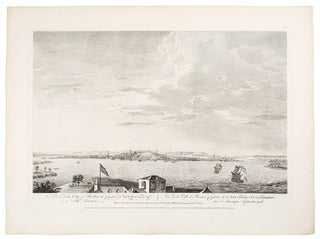SCENOGRAPHIA AMERICANA - Thomas POWNALL (1722-1805), after.
A View of the City of Boston the Capital of New England, in North America ... Drawn on the Spot by his Excellency, Governor Pownal; Painted by Mr. Pugh, & Engraved by P.C. Canot
London: printed for John Bowles, Robert Sayer, Thomas Jefferys, Carington Bowles and Henry Parker, [circa 1768]. Copper engraving by P.C. Canot after a painting by Pugh from a design by Pownall, on laid paper. Plate mark: 14 1/2 x 20 3/4 inches. Sheet size: 17 3/4 x 24 1/4 inches.
An important image of colonial Boston from the famous and very rare Scenographia Americana series: a strong impression with wide margins.
Pownall's drawing of Boston, here ably engraved by Peter Charles Canot (1710-1777), was one of six prints in the Scenographia Americana series that were based on Pownall's sketches. This particular image was worked up into a painting by Pugh and it was from this that the engraving was made by Canot. The complete Scenographia Americana (with a total of 28 plates) is a legendary rarity. The individual prints are therefore all that the collector can realistically hope to acquire, and the present image is one of the most important. Taken from the vantage point of Castle William across the Harbor to the southeast, from left to right one makes out South Cove, South Battery, Fort Hill, a line of vessels docked along Long Wharf, and the mouth of the Charles River. Behind Long Wharf are visible the three peaks of the Trimontane, of which only Beacon Hill remains today. In the near foreground the fortifications of Castle William command the shipping channel between Castle and Governors islands, through which two British naval vessels have just safely passed. Governor Thomas Pownall, one of the few sympathetic colonial governors in North America, was also an artist, author and mapmaker. He first came to America as secretary of the governor of New York, Sir Danvers Osborn, in 1753, who committed suicide a few days after arriving. Pownall stayed on in America and became deeply involved in colonial politics during these critical years (the French and Indian War). He contributed to and supported Pitt's strategy in the war against the French and was appointed governor of Massachusetts, replacing Shirley, in August of 1757. He was at first very popular, energetically raising troops and prosecuting the war with the French, but political rivalry and objections to his own rather free lifestyle and manners led to his retirement from the position at his own request, returning to England in 1760. He remained a staunch supporter of the American causes as they arose in the 1760s. Interestingly, he was very much in favor of emancipation of the slaves in America. Pownall was a long-time friend of Benjamin Franklin. The dating of this issue, with the added imprint, is ascribed from the mid-1760s to as late as 1774, i.e. after Carington Bowles took over the business in St. Paul's Churchyard but before Sayer began trading as Sayer & Bennett.
Deak, 106; Stokes and Haskell, American Historical Prints, 1758-B-86; Winsor, Memorial History of Boston, p. II:127.
Item #36009
Price: $9,500.00



